
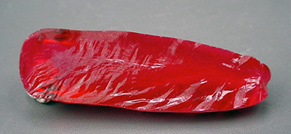

These terms, which are commonly used to describe gems that are not natural gemstones, but which are being sold in place of a natural gemstone, can easily be misused and/or misunderstood. Let's take an example: if I have a natural ruby (one made by Mother Nature's processes) and I represent it as a natural ruby, fine. But under what conditions would I have an example of a synthetic, a simulant and a fake ruby?
First things first: the word, "gemstone". According to FTC regulations, which guide the gem and jewelry industry's trade and advertising, only natural mineral and organic materials can be legally and ethically sold and advertised as "gemstones". Other terminology, such as "synthetic" or the equivalent terms "cultured", "created" or "laboratory grown" must be used for materials which did not originate in Nature.
A synthetic has been manufactured in a laboratory or factory. Synthetics may or may not have natural analogs. Synthetic ruby, for example, is a man-made version of natural ruby and is virtually identical to it in both chemical composition and crystal structure. As a result both types show the same physical and optical properties (like density and refractive index).



Cubic zirconia and YAG (yttrium aluminum garnet) are examples of synthetics which have no exact natural counterparts and have their own unique chemical compositions and/or crystal structures.
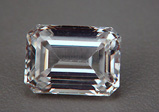
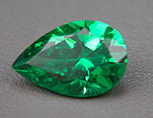
The first synthetics, produced in a size and at a cost to make them marketable, were synthetic rubies made by August Verneuil around 1900. (Many people don't realize that synthetics go that far back, and have been bitterly disappointed to find that the wonderful Edwardian or Art Nouveau ring they inherited from Great Aunt Minnie was set with a synthetic!) In fact, synthetics were, for a while, with some designers, kind of the "cool new thing" and were not relegated to second tier or mass produced jewelry as they tend to be today.
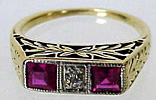
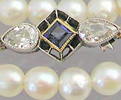
The process Verneuil developed, called "flame fusion" is still the main one being used to produce synthetic corundum and synthetic spinel. A powdered source material, like aluminum oxide for corundum with, a metallic oxide such as chromium oxide to provide the red color, is melted. As it drops through an oxy-hydrogen torch flame the molten material crystalizes as it hits a ceramic platform at the, cooler, base of the furnace. As the crystal grows the platform is turned and lowered, creating a carrot-shaped "boule".
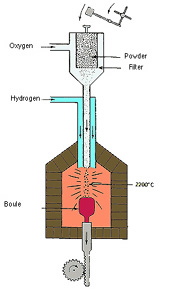
Because synthetics have the same optical, chemical and physical properties as the natural materials they mimic, standard gemological tests are not very useful in identifying them. In these cases the microscope becomes a gemologist's most valuable tool in separating the synthetics from gems of natural origin. There are microscopic inclusions which occur only in natural gems, and those which occur only in synthetics. Unfortunately, there are also many inclusions which can occur in either type, and flawless stones with no inclusions to see.
The flame fusion materials are usually the easiest type of synthetics to discriminate from their natural counterparts. The most definitive sign is known as "curved striae" which under magnification, in diffused light, look a bit like the grooves on an old vinyl recording.
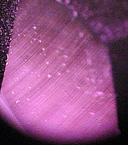
Triangular platinum crystals (from the crucible) such as seen in a "flux melt" synthetic Alexandrite are another absolute indicator of synthetic status.
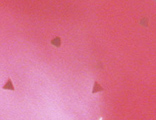
Over the years many new processes have been developed which, although more expensive and time consuming, produce synthetics which have more natural looking colors and inclusions. Some of these, like the hydrothermal process, which is responsible for so much of the synthetic emerald in commerce, mimic the conditions of Nature, others likeVerneuil's are entirely human inventions.
A simulant is any material, natural or synthetic, that looks like, and is used in place of, another material (natural or synthetic), but is not represented to be the natural gem. The term, "imitation" is equivalent to simulant. For example a natural simulant of ruby is the gemstone, red spinel which can have a color and luster very like that of a ruby. On the other hand, red, man-made glass has long been used as an inexpenisve ruby simulant.
Simulants have been around since antiquity. As early as 4700 BC, Eqyptians produced a non-clay, ceramic compound, colored by copper, called faience with an appearance very similar to turquoise.

In the 18th century Joseph Strass, of Vienna, developed a particularly brilliant and dispersive type of lead containing glass, which came to be known as "strass" or flint glass, and which was widely used as a diamond simulant. Today this dispersive type of leaded glass, is generally marketed as "crystal" (a misnomer, of course, since all glasses are amorphous, not crystalline).
Simulants are less common than they once were as the availability of relatively inexpensive synthetics for many materials have made them less desirable.
Some gems that are still commonly simulated, though, include "faux": pearls, turquoise, opal, coral, emerald and of course, diamonds.
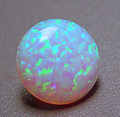

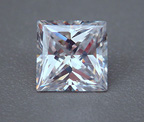
A fake is any gem material, natural or synthetic, which is misrepresented to be any other gem material, natural or synthetic. A synthetic ruby, a natural red spinel, or a piece of red glass would all be fakes if represented as natural rubies. Whether something is a "fake" rather than a synthetic or a simulant is a matter of intention and disclosure. When misrepresentation occurs (whether knowingly or not) then you have a fake. Fakes have been around as long as there have been been dishonest, and greedy sellers and gullible buyers.
A rather recent case in point occurred after the Mt. St. Helen's eruption in the US. Materials, purported to be made from the eruption ash, appeared on the market under various names: Helenite, Mt. St. Helen's Emerald, Obsidianite and Mt. St. Helen's Glass. Prices ranged from modest to $100/ct. Subsequent laboratory analysis of these pieces showed that they contained, if anything, a barely measureable trace of ash from the eruption and were quite ordinary man-made green glass.
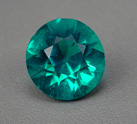
When "natural" transparent gems are sold in closed mountings so that the crown is the only visible part, your "fake detector" should be on alert. Certainly there are cases when such gems are exactly what they are purported to be, but the vast majority of fakes are set in this way, especially in vintage jewelry.
.gif)
One of the most important roles of GIA (Gemological Institute of America), AGTA (American Gem Trade Association), IGS (International Gem Society) and other gem organizations has been in developing testing procedures and instruments, and in educating honest dealers and intelligent buyers in an ongoing effort to keep one step ahead of those who would deceive.